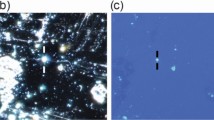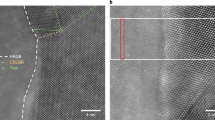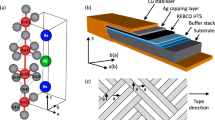Abstract
Mason and Knibbs1 have recently measured the thermal resistivity of poly crystalline graphite of various crystallite sizes irradiated for various doses at 250°–275° C. They explain the extra phonon scattering arising from the irradiation by attributing it to interstitial clusters, one cluster per crystallite-plane, and they reckon that vacancies make only a small contribution. This explanation is not entirely satisfying. For, at all crystallite sizes studied1, the increase of thermal resistivity on irradiation was found experimentally to be comparable with the thermal resistivity before irradiation, implying that the mean free path of scattering from irradiation-induced defects, Li, is comparable with the mean free path for crystallite-boundary scattering, La, which is taken as equal to the mean crystallite diameter. This means that if there is only one scattering defect per crystallite-plane, then the diameter of this defect is a substantial fraction of the crystallite diameter, and therefore the concentration of surviving interstitials is large, say at least 10 per cent. With a dose of only 177 MWD/Ate, however, the number of displaced atoms calculated by the Kinchin–Pease method2 is only about 2 per cent and at 250° C a large proportion of these are lost by recombination with vacancies; this is confirmed by electron microscopy of single crystals3 and by stored energy results4. There cannot, therefore, be enough interstitials to construct the defects postulated.
This is a preview of subscription content, access via your institution
Access options
Subscribe to this journal
Receive 51 print issues and online access
$199.00 per year
only $3.90 per issue
Buy this article
- Purchase on Springer Link
- Instant access to full article PDF
Prices may be subject to local taxes which are calculated during checkout
Similar content being viewed by others
References
Mason, I. B., and Knibbs, R. H., Nature, 198, 850 (1963).
Kinchin, G. H., and Pease, R. S., Rep. Prog. Phys., 18, 1 (1955).
Reynolds, W. N., and Thrower, P. A., I.A.E.A. Symp. Irradiation Damage, Venice (1962).
Bell, J., et al., Phil. Trans. Roy. Soc., A, 254, 361 (1962).
Woolley, R. L., Brit. J. App. Phys. (in the press).
Ziman, J., Electrons and Phonons (Oxford Univ. Press, 1960).
Author information
Authors and Affiliations
Rights and permissions
About this article
Cite this article
WOOLLEY, R. Thermal Resistivity of Irradiated Graphite. Nature 199, 684–685 (1963). https://doi.org/10.1038/199684b0
Issue Date:
DOI: https://doi.org/10.1038/199684b0
Comments
By submitting a comment you agree to abide by our Terms and Community Guidelines. If you find something abusive or that does not comply with our terms or guidelines please flag it as inappropriate.



